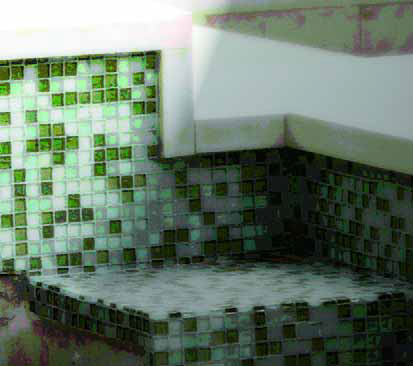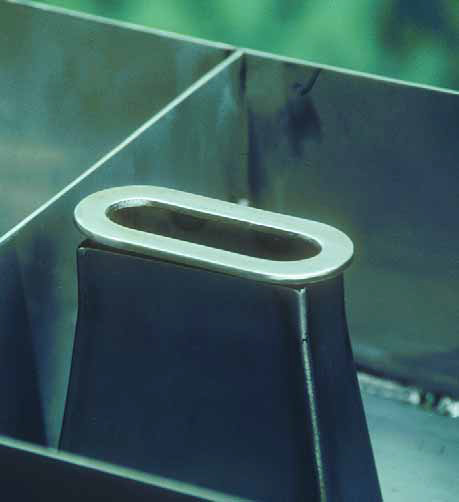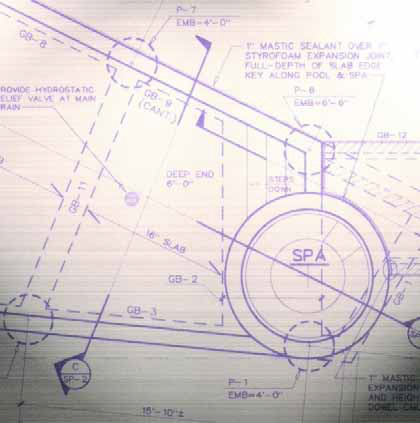precision
With some details, seeing is believing. That's certainly the case with the one we'll consider in this column, where the images will do much of the work in defining a simple but elegant way of making a statement with any raised bond beam or wall. Yet again, it's testimonial to the good things that happen when watershapers know how to control materials and infuse their work with visual appeal. Most of the time when pool people build small or medium-size walls, they'll automatically be topped with some form of coping or capstone - anything from poured-in-place concrete or stone to brick or some pre-fabricated coping. Many of these walls are
When I first entered the watershaping industry in the late 1970s, one of the details to which I took an immediate dislike was the practice of wrapping the tile that covered the walls of raised bond beams around the corner and onto step risers and various other vertical hardscape surfaces found around pools and spas. We've all seen it - Spanish Colonial Revivalist tiles of questionable authenticity, extra-bold in color and used to cover highly visible vertical surfaces. To me, these swaths invariably look out of place and have the effect of drawing attention to features that often don't warrant or benefit from the emphasis. It happens to this day because
When you ask people about transparent building materials, most people immediately think of glass. Glass is certainly stronger than most people realize, but it has never been an ideal structural material because of its weight, brittleness and structural limitations. With our acrylic products, by contrast, architects and other designers have found a material with which they can create substantial transparent structures that are much lighter and more versatile than those made with glass – and with a structural strength more than double that of concrete. R-Cast acrylic (as we call it) is indeed an amazing material: Its uses span from the obvious pools, fountains or aquariums to awesome signage and seemingly impossible structures and lighting (to mention a few possibilities). Its combination of optical clarity with safety, strength, flexibility and UV resistance has allowed an increasing numbers of designers across a range of disciplines to embrace the material as never before. There are several firms that provide acrylic materials to the construction marketplace, with
The latest generation of Las Vegas hotels and casinos offers an amazing showcase for pools, fountains and watershapes of every shape and size. In fact, for many such properties, the presence of these increasingly imaginative watershapes is crucial to defining their appeal for huge numbers of guests and visitors. As these properties and their watershapes have become more elaborate and unconventional, they've presented designers, engineers and builders with greater and greater technical challenges - many of them carried in the plain fact that water can inflict a great deal of damage on these facilities if it is not properly contained and controlled. In our end of the watershaping trades, the visual and sensory arms race has challenged the waterproofing industry to step up to the plate and manage the integrity of every nook and cranny of every vessel, be it wide or narrow, curved or straight, below-grade or
As the fields of landscape architecture and watershaping intermingle, the knowledge bases for each trade increasingly need to be shared across various design, engineering and construction disciplines. That sharing, unfortunately, has been relatively slow to develop, which means that, as a designer and builder and of custom high-end watershape and landscape projects, I am often frustrated by the lack of detail I find in plans and specifications generated on all levels of the trade. Although this deficiency flows freely from all sectors, the most frequent sources of inadequacy in watershape plans are landscape architects and designers, too many of whom offer information that is disturbingly vague and thoroughly lacking in detail. We've all seen the blue patch on the overhead plan view - a grossly inadequate delineation of a significant design component if ever there was one. Contractors presented with such documentation are left to define specific details themselves and essentially are asked to build some version of that blue patch as they
If you've been following this column for the past several issues, you already know a good bit about the magnificent (and magnificently difficult) project I completed late last year in the Malibu Colony. Many times in those columns, I mentioned (mostly in passing) a system of four deck-level laminar jets we planned on installing. As was the case with just about everything else on this project, incorporating the system of jets into the courtyard environment turned out to be far more complicated and challenging than we ever thought it would be. When all was said and done, however, we all agreed that meeting this particular challenge was
Why is it that, on the pool/spa side of the watershaping business, it's so difficult to find much by way of truly workable plans and specifications? In residential work, of course, the tone is set by local building inspectors and plan checkers, whose needs seem to vary tremendously from place to place. But that's no excuse for the fact that the plans used in a great many residential projects are grossly inadequate - especially when compared to the far more detailed and precise plans and specifications required by




















